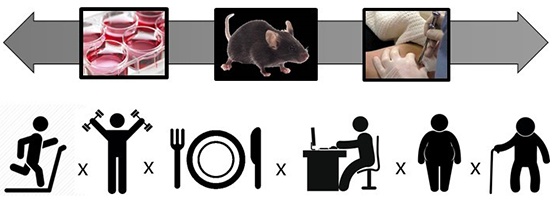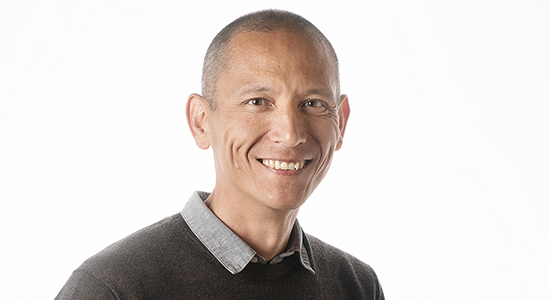Muscle growth and metabolism
- Identifying and characterizing novel phospho- and redox signaling proteins in the contexts of acute and chronic exercise adaptation, insulin resistance and anabolic resistance. We strive to study cell signaling from the global proteomic level to the subcellular compartmentalized level.
- Regulation of muscle GLUT4 translocation and glucose uptake by exercise and insulin-stimulation in heath and disease.
- Regulation of muscle hypertrophy and atrophy by exercise and disuse.
- Cancer-associated muscle wasting (cachexia) and its cross-talk with insulin action.
Skeletal muscle, comprising ~40% of human body mass, is necessary for locomotion, a major site of macronutrient storage and metabolism. Inactivity, nutrient excess and ageing adversely affect skeletal muscle function and share several overlapping pathological traits. These include changes in the extracellular matrix (ECM) , oxidative stress, low-grade inflammation and intracellular disturbances in protein, organelle and redox-homeostasis. Within skeletal muscle fibers, the predominant cell type of skeletal muscle tissue, the above factors have all been linked to impaired metabolism (e.g. insulin resistance) and decreased maintenance of muscle mass/strength.
Regular exercise is among the most powerful interventions to curb these muscular calamities. Intriguingly, apart from improving muscle fiber function itself, these interventions also stimulate beneficial adaptations in other cell types within the muscle tissue and throughout the body through the release of para/endocrine signals in the form of myokines and/or exosomes from the muscle fibers and other cell types.
The goal of our research is to identify the molecular mechanisms causing muscle dysfunction in different contexts and how physical activity impacts on these. To accomplish this, we work in experimental systems ranging from cell culture to mouse models to the intact human. In these, we apply state-of-the-art methods ranging from global omics-methods to classical biochemistry, transgenic muscles and advanced microscopy of in vivo transfected biosensors.
We are always looking for bright, highly motivated people to join our team. Our lab has a mix of Danish and foreign people, so the working language is English. If you are interested in working with us, please contact Thomas TEJensen@nexs.ku.dk or Erik ERichter@nexs.ku.dk.
- Potential PhD students from abroad: Please be aware of the possibility of becoming a double-degree PhD student (partial funding from the University of Copenhagen and a degree from both your home University and the University of Copenhagen in the end). Conditions can be viewed here.
- Potential post docs: No open positions but we may be interested in co-applying for research funding if you want to join our lab.
Research projects
Skeletal muscle insulin resistance - a contributing factor to the development of type 2 diabetes - and loss of muscle mass are well-known consequences of physical inactivity, overweight and aging, and contribute to increased morbidity and mortality.
Conversely, various forms of physical activity can improve muscle metabolism and increase muscle mass. 
A better molecular understanding of what goes wrong in muscle disease and how physical activity counteracts this is important, not only for our basic physiological understanding, but for the development of future drugs.
The main themes
1) What role do different sources of reactive oxygen species play in muscle stress adaptations?
Redox-signaling by reactive oxygen species (ROS) was once considered universally harmful to living organisms but is today known to play positive roles as signaling molecules that control cell function.
We investigate the determinants and role of altered subcellular ROS concentrations in different sub-regions of muscle cells, in particular the diffusible redox second messenger hydrogen peroxide, both in relation to muscle disease and adaptations to physical activity.
2) GLUT4 regulation in striated muscle
Contraction and insulin-responsive glucose uptake into different tissues including heart muscle, skeletal muscle and adipose tissue is accomplished by translocation of glucose transporter 4 (GLUT4) from intracellular depots to the cell surface.
Using various types of microscopy, we study the localization of GLUT4 and when and where the subcellular cell signaling meets the GLUT4 machinery in human biopsy material, advanced 3D printed cell culture and transgenic animal models.
3) Novel phospho-signaling networks
Phosphorylation by kinases is a well-established regulator of cellular function. Recent advances in mass spectrometry based phosphoproteomics have identified thousands of new phosphosites, the function of which is unknown. Furthermore, the function of many kinases remains ill-defined in skeletal muscle.
Using cultured cells and transgenic animal models, we study the function of some of these kinase signaling networks under various conditions in mainly skeletal muscle.
4) Towards more metabolically mature human striated muscle models
Studying cause-effect relationships of relevance to humans is best done in a model system of human origin. Cell culture of adult human cardiac and skeletal (striated) muscle could be a solution but their utility is currently hampered by poor diffentiation and metabolic maturity.
To solve this, ongoing work with researchers at DTU and Novo Nordisk aims to test combinations of prolonged culture, electrical stimulation, combination of different cell types (e.g. innervated nerve-muscle constructs) and 3D printed configurations of cells and substrates, hoping to produce better models of human striated muscle for basic research and drug testing.
Funded by
We are grateful for our current funding by:
Lundbeck Foundation Ascending Investigator grant
“Illuminating the Molecular Switches regulating Muscle Stress Adaptation”
2020-2023
Novo Nordisk Foundation Synergy project
“Illuminating the Dark Redox Proteome”
Co-recipient (Erik Richter main PI), 2021-2024
Novo Nordisk Foundation Ascending Investigator grant - Endocrinology and Metabolism
“Exploring Mechanistic Determinants of Striated Muscle Insulin-sensitivity across the Health-Disease Spectrum (SIDETRAC)”
2023-2028
Danish Diabetes Academy and Innovationsfonden industrial postdoc projects
2022-2024
The hormone growth and differentiation factor 15 (GDF15) is known to decrease food intake in rodents and its concentration in the blood is increased with exercise and pregnancy but also with severe illness. It role in the body therefore remains a mystery.
We have shown in preliminary investigations that treatment with GDF15 for 5 days in mice dramatically increases insulin action in the liver and in muscles. This is a novel and very exciting finding.
The project aims at clarifying the molecular mechanisms behind this effect and also determine if the effect is elicited through the known receptor for GDF15 (GFRAL) which is located exclusively in the brain. This will be done by administering GDF15 directly in the brain as well as studying whether the effect of GDF15 is abrogated in mice that do not have the GFRAL receptor in the brain. Finally, since GDF15 increases with exercise we will determine whether this increase is important for increasing insulin action with exercise training.
Contact
Professor Erik A. Richter
Transport of glucose from the capillaries to the muscle interstitium is thought to take place through endothelial pores between the endothelial cells.
However, the endothelial cells in muscles express a large amount of GLUT1 transporters and in the project it is investigated whether these transporters participate in the transendothelial glucose transport.
This is done by measuring the interstitial glucose concentration by microdialysis in mouse muscles under a euglycemic hyperinsulinemic clamp. The mice are either control mice or mice with inducible knock-out of GLUT1 in the endothelial cells.
Contact
Professor Erik A. Richter
Increased insulin sensitivity of glucose uptake after exercise is well described but only evaluated with the laboratory tool the euglycemic hyperinsulinemic clamp.
Under these conditions the interstitial glucose concentration appears to become limiting for glucose uptake likely because of hyperinsulinemia in the absence of hyperglycemia.
We want to investigate the real life situation where insulin sensitivity following exercise is studied when individuals are fed a carbohydrate rich meal where hyperglycemia will be accompanied by endogenous hyperinsulinemia and secretion of vasoactive incretin hormones.
The hypothesis is that when fed a meal instead of a clamp, leg glucose uptake and the effect of exercise will be larger and the rate limiting steps for glucose uptake different.
Contact
Professor Erik A. Richter
COMPLETED PROJECT
Physical activity and nutrition for improvements of health was a research initiative targeting the potential of and mechanisms, by which physical activity and proper nutrition could improve physical health and well-being, facilitate treatment, rehabilitation and even prevent certain diseases.
The overall aim was to create an inter-disciplinary and cross-facultary research unit at the University of Copenhagen that generates and communicates evidence-based life style recommendations ´tailored´ for population groups at risk of impaired health, well-being and overall quality of life.
Download final evaluation
Final evaluation for Physical activity and nutrition for improvements of health.
Funded by
Physical activity and nutrition for improvements of health was one of the 18 research initiatives established in 2013 based on a grant from the 'University of Copenhagen Excellence Programme for Interdisciplinary Research (2016)'.
Contact
Professor Erik A. Richter
Members of research group
| Name | Title | Phone | |
|---|---|---|---|
| Erik A. Richter | Professor | +4535321626 | |
| Jonas Roland Knudsen | Postdoc | ||
| Kaspar Wredstrøm Persson | PhD Fellow | +4535320305 | |
| Roberto Andrés Meneses Valdés | PhD Student | ||
| Thomas Elbenhardt Jensen | Associate Professor |

